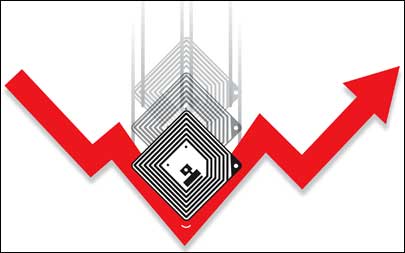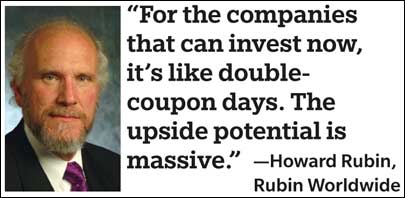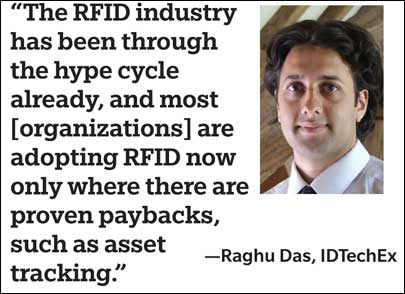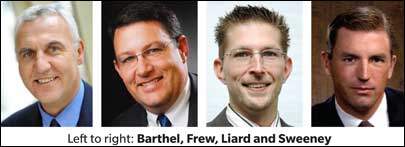Feb 01, 2009With economic uncertainty stretching well into 2009, businesses around the globe are retrenching to ride out the downturn. Lean times demand tighter budgets, and that includes cutting back on technology spending. But businesses that cut too much—or trim the wrong things—run the risk of stifling innovation and hampering their profitability and competitiveness for years to come, according to technology management consultants and economic experts.
Casting a look back at previous recessionary cycles, there are lessons to be learned from companies that continued to invest in technology even while the economy slumped. An October 2008 report by Diamond Management & Technology Consultants studied the performance of more than 400 publicly traded companies with revenues of at least $100 million before, during and after the last recession, which was defined as occurring from 1998 to 2004. Various financial indicators, including return on equity and return on invested capital, were used to measure performance. Each company's investment and expenditure patterns were analyzed as well.
The report's central finding: While most companies reduced spending during the recession, the superior performers avoided the temptation to make across-the-board cutbacks. Instead, they dug deeply into their operational data and analyzed that information to determine where and how they could become more efficient. They made choices regarding which strategies to pursue and what resources, including technologies, they needed to meet their goals and achieve growth. Those choices had a direct impact on the bottom line. The research showed that the top performers created more than $350 billion in market value, while those companies whose performance weakened lost more than $200 billion.
Throughout the downturn, market leaders such as Southwest Airlines and the Progressive Group of Insurance Companies continued to invest in technologies that supported their broader strategic initiatives and delivered long-term value, says John Sviokla, vice chairman of Chicago-based Diamond. "The leaders find a way," he says. "They make the hard choices. They cut things that don't add value." In the companies Diamond studied, several trends emerged among the top performers, including investing in technologies that automate processes and enable customer self-service.
Whether the economy is booming or contracting, smart businesses look at technology as an enabler of two key sources of growth—innovation and enterprise integration, says James I. Cash, Ph.D., an emeritus professor at Harvard Business School who has studied hundreds of companies and their strategic use of technology for competitive advantage during his 27 years at HBS. "You don't stop and start innovation and growth processes," he says. Cash's research shows that during lean economic times, companies have to adjust by funding fewer projects, reducing the time required for ROI analysis, or identifying partners to share risks and costs. During a recession, investing wisely in technology can deliver significant payback when the good times return, he says.
Investing in technology during a downturn while competitors are slashing technology projects not only positions a business for growth, it can give that company a huge long-term advantage because of the high costs of playing catch-up, says Howard Rubin, CEO of Rubin Worldwide, a technology economics research firm based in New York. During a recession, prices of technology hardware and services may be more favorable, and the sooner projects move forward, the more quickly operational improvements kick in. "For the companies that can invest now, it's like double-coupon days," Rubin says. "The upside potential is massive. For companies that kill investments, the cost of catching up is massive. Anyone who has to rush to market has to pay high costs to catch up."
When corporate spending plans come under rigorous review, technology consultants and economic experts say projects that offer benefits such as automating processes, providing supply-chain visibility and improving inventory management tend to be the ones most likely to get funded. "What's ripe for investment? Anything that takes the cost out of business," says Frank Scavo, president of Computer Economics, an IT research and advisory firm in Irvine, Calif. "IT spending is part of the solution to increase productivity in business. A dollar invested in IT results in productivity gains over the long term."
The experts also agree that when spending is being cut, technology investments that offer the potential for a relatively fast return on investment—say, in six to 12 months—are often the ones that get the go-ahead. "Looking at technology investments, companies have to go short," Rubin says. "In flush times, you can do things in five- to seven-year cycles."
In many cases, RFID has earned a reputation as technology that can provide rapid ROI and deliver operational efficiencies, experts say. Relatively new technologies such as RFID may be part of the solution to the recession rather than the victim of it, says Jonathan Rosen, executive director of the Institute for Technology Entrepreneurship and Commercialization (ITEC) at Boston University's School of Management. "RFID is an interesting technology to look at in this context because it offers dramatic increases in cost savings and efficiency," Rosen says. "A technology like that is not only going to survive a difficult economic time, it also may be a driver for recovery."
RFID can also deliver the fast ROI that many companies demand as a basic requirement for funding any project during an economic downturn. "The RFID industry has been through the hype cycle already, and most [organizations] are adopting RFID now only where there are proven paybacks, such as asset tracking," says Raghu Das, CEO of IDTechEx, a market research and consulting firm. "These can pay for themselves quickly, and if anything, companies may continue as normal or even speed up adoption because it can significantly reduce costs, giving them a competitive advantage." Das predicts that global demand for RFID technology should remain steady, helped by new trends in financing RFID projects.
To help you identify the RFID project that can enable your company to save money now and position it for future growth, we've identified seven closed-loop applications that have delivered the fast ROI—within 12 months—that so many businesses are demanding in the current environment. We also provide examples in each category of companies in different industries that achieved an ROI within a year.
While these RFID applications can deliver an ROI within a year, deploying an RFID system can be complex and costly. And with businesses demanding rigorous justification of any technology spending proposals, it's more important than ever to have a clearly defined business plan before launching an RFID project. "There's more intense scrutiny," says ITEC's Rosen. "There's more risk aversion inside companies. It's harder to sell ideas to management now than it was a year ago."
Organizations that have a clearly defined business plan, conduct rigorous up-front planning, and have the agility to move quickly to adapt systems and processes can help minimize disruption and pave the way for a smooth rollout. With the growth of RFID adoption in recent years, there are numerous examples of successful deployments in large and small companies across a range of industries. Many of these companies have shared the lessons they've learned.
While each RFID project is unique, they all offer one common piece of advice: Take the right steps—analyze the benefits and risks of deploying RFID, put a project team in place that understands the processes and systems that will be affected, select the appropriate technology and, in many cases, hire an experienced systems integrator that fully understands the goals of the project. (See The Road to ROI: How to Build a Bottom-Up Business Case, Plan an RFID Rollout That Stays on Track, Plan an RFID Field Trial That Delivers and Choosing the Right Systems Integrator.)
1. Whether you're tracking defibrillators in hospitals, equipment in data centers or cars that move coal out of a mine, asset tracking can deliver an ROI, because you can sell assets you don't need or eliminate unnecessary purchases. Returnable assets, equipment that is frequently lost or stolen, and high-value assets are all solid candidates for tracking with RFID. The ROI depends on the cost and value of the assets being tracked and how much waste or inefficiency is being eliminated.
The University of California San Diego Medical Center deployed a real-time locating system to track a variety of items, including wheelchairs, IV pumps and headlamps worn by surgeons. The hospital estimates it has saved approximately $70,000 annually on IV pumps alone, since knowing where the pumps are located eliminated the need to rent pumps on a daily basis (see UCSD Medical Center Expands Its RFID Deployment).
NYK Logistics is using an RFID yard-management system to track containers at its Norfolk, Va., and Long Beach, Calif., facilities. The system has reduced labor costs and improved efficiencies, saving the company $500,000 annually at the Long Beach facility (see NYK Logistics Adds RFID to Va. Facility).
In a typical year, Mexico's Regiomontana University had been suffering about $15,000 in theft of its assets—primarily the projectors or laptops stationed in each classroom. Since the university installed an RFID tracking system, no equipment has been stolen (see RFID Helps Mexican University Retain, Maintain Equipment).
2. Paper-intensive businesses—including financial services enterprises, government agencies, health-care organizations, law firms, pharmaceutical companies and universities—can reduce the time spent and cost incurred looking for lost or misplaced files and archived documents. Such tracking can also ease the financial and legal impact associated with losing documents.
Since Fulbright & Jaworski implemented an RFID file-tracking system, the law firm reduced costs associated with searching for case files by nearly 50 percent. It recouped the project costs in eight months.
Florida State University is employing RFID to keep track of thousands of research grant files, saving time and money. The university recouped its investment in less than a year (see RFID Brings Order to a Chaotic Office).
Hypo Landesbank Vorarlberg, an Austrian bank, employed an RFID-based system to track the paper files it keeps on each loan it makes to customers. The bank has never calculated an ROI, but it estimates the system has already paid for itself more than 50 times over.
3. Manufacturers, distributors and retailers can use RFID to automate the tracking of supplies and finished goods. Inventory management can help pinpoint the location and status of raw materials, ensuring they are where they need to be to better manage just-in-time production. It also can improve the visibility of finished goods, reducing out-of-stocks and write-downs on obsolete inventory.
EV3, a manufacturer of stents and other medical devices used by vascular surgeons, deployed an RFID inventory management system that, it says, gives the company a competitive edge. The system saves the company's field staff valuable time and increases inventory accuracy, resulting in fewer inventory write-offs (see EV3 Uses RFID to Streamline Inventory).
Tomorrow's Mother, which manufactures and markets maternity apparel in 380 stores throughout the United States and Canada, is rolling out an RFID system to obtain a timely, accurate inventory of clothing items in each store. It's too early for ROI data, but after a successful pilot, the company has RFID-enabled 20 additional stores (see Maternity Apparel Maker Gives Birth to Smart Displays in Stores).
Viracon, an architectural glass fabricator, deployed an RFID real-time locating system that tracks products through production, to better manage inventory and orders. The company completed a cost-benefit analysis and anticipates an ROI in approximately a year (see Glass Fabricator Increases Visibility With RFID).
4. Aerospace, defense, equipment and transportation manufacturers are among the companies that can cut production downtime by ensuring the right parts are where they need to be. Parts tracking can also reduce stock levels of spare parts and improve recordkeeping, allowing for more accurate production and inventory planning.
After Airbus employed RFID to automate container tracking on its A380 assembly line in Hamburg, the airplane maker found that the overall number of containers needed dropped by 8 percent when compared with the manual tracking process (see Airbus' Grand Plans for RFID).
At its Ontario plant, Cami Automotive has seen significant benefits from using an RFID system for parts replenishment. Parts are now kept in storage off the assembly floor, enabling the company to devote 50 percent more floor space to the manufacturing line, which has helped it improve production significantly (see Cami Expands Its RFID Deployment).
Continental AG, a German automotive supplier, employed an RFID system to track components from the time they are removed from shelves in its warehouse until they are assembled in a clean room. Continental has not yet calculated an ROI, since the focus of the application is on process improvement, but the company says it's been able to transfer four people to different jobs (see RFID Helps Continental Clean Up Its Operations).
5. RFID tags with temperature sensors can be used to check the condition of perishable goods such as chemicals, flowers, food and pharmaceuticals, as well as parts used in manufacturing. Real-time data allows businesses to take corrective action to prevent spoilage. It can also ensure regulatory compliance and patient safety.
Swiss retail chain Manor is using RFID to monitor the temperatures of its freezers and refrigerators to reduce food spoilage. Manor declines to reveal the amount of money it lost annually before installing the RFID system currently in use at 30 stores, but the retailer says it receives about 10 alerts per day, as well as monthly reports that provide valuable information for making business and operational decisions (see At Manor, RFID Keeps Food From Spoiling).
Boeing Phantom Works, the advanced research-and-development unit at Boeing, employed an RFID temperature-monitoring solution to track pre-frozen mixed sealants. The manufacturer says the estimated cost to develop and implement the system was less than the cost savings (see RFID Journal LIVE! 2008 Report).
DHL, the express and logistics brand of Deutsche Post World Net, developed an RFID- and sensor-based system that tracks the temperatures of shipments at various points from departure to arrival, and makes that data available to customers in real time over the Web. It can help pharmaceutical companies that make temperature-sensitive drugs save millions of dollars by giving them more control over their distribution process (see Best Use of RFID in a Service: A Prescription for Spoiled Drugs).
6. RFID is used to monitor and manage the fleets of cars, trucks, buses and other vehicles owned by automakers and dealers, government agencies, and transportation and distribution companies. The automated tracking eliminates unreliable and costly manual processes and improves resource planning.
One year after deploying an RFID system to track newly assembled vehicles at its plant in Solihull, England, Land Rover realized a return on its initial investment. The system reduces labor and ensures the vehicles are shipped at the right time (see Land Rover Finds ROI in Tracking New Cars).
The city council of Melbourne, Australia, is tracking fleet vehicles in its corporate parking lot. The council estimates that once the RFID system is fully integrated and operational, it will improve efficiencies and deliver an ROI within the first couple of months (see Melbourne City Council Tracks Its Car Fleet).
Long Beach and Los Angeles seaports are leveraging RFID to expedite trucking operations, improve air quality and bolster security. The system has produced immediate and impressive results (see The Green Technology and SoCal Seaports Leverage RFID to Reduce Pollution).
7. Whether you're producing clothing, electronics or defense systems, RFID can improve the cost, safety and reliability of managing WIP during manufacturing. It allows real-time visibility on processes, assets and workers during every step of manufacturing, providing insights that can lead to improved workflow and production planning.
Endwave Defense Systems is employing RFID to gain visibility on its production floor and monitor the status of WIP at its facility in Diamond Springs, Calif. The company expects to see cost reductions comparable to at least one full-time employee, as well as improved customer satisfaction. The complete solution cost less than $100,000 (see RFID Helps Endwave Track Work-in-Progress).
Hong Kong knitwear company Crystal Group is using RFID to track garments as they are manufactured. The factories recouped the cost of their RFID investment within a year of deployment, due to improvements in workflow (see Crystal Group Uses RFID Tags to Track Garment Production).
Hewlett-Packard Brazil deployed an RFID WIP system to analyze processes used to manufacture and distribute printers. With the increased visibility, the company estimates it's been able to reduce its printer inventory in the supply chain by 17 percent and says it is now closer to perfect order fulfillment (see Best RFID Implementation: Keeping Tabs on Printers).
There are other applications that can deliver value, including two promising ones that are worth consideration. All-in-one tool-tracking systems automate the process of identifying and locating tools used in manufacturing and other industries. These systems eliminate the need for employees to manually search for tools, allowing them to do higher-value work and reducing the likelihood of work stoppages due to misplaced equipment (see What You Need to Know About RFID Tool-Tracking Systems). And anti-theft systems, which often combine RFID and video technologies, can reduce shrinkage in warehouses and retail stores (see Sony Europe Implements Video-RFID Tracking System and Retailers See RFID's Potential to Fight Shrinkage).
Despite the bleak economy, several developments are taking shape that could propel RFID adoption in 2009, by helping to reduce the risks and accelerate the rewards for companies and organizations looking to deploy the technology. Some technology vendors are recognizing the need to help their customers arrange financing for RFID systems in light of the tightened credit markets.
For example, Microsoft and Xterprise, an RFID software and services provider, announced a partnership last November to offer financing for RFID hardware, software and services. During pilot projects, companies can defer payments until after they derive value from the system, for up to six months, says Xterprise CEO Dean Frew. Within the first month of the program's launch, as many as five deals were in the pipeline, he says, noting that the projects likely wouldn't have happened without the financing.
Microsoft has also partnered with Hewlett-Packard and Motorola to market IT asset-tracking systems for improved management of data-center operations. Offering a complete RFID package, including hardware, software, integration and support services, is key to making RFID adoption more attractive by reducing the risk for companies interested in investing in the technology, says Michael Liard, research director of RFID and contactless technology at ABI Research. "We need to see fused, holistic partnerships," Liard says. "The partnerships are important for taking projects beyond the pilot stage."
Henri Barthel, who oversees BRIDGE (Building Radio Frequency Identification Solutions for the Global Environment), an initiative to help European businesses and organizations deploy RFID and EPCglobal network applications, agrees that companies want an end-to-end approach when they deploy RFID. "Users are looking for total solutions," he says, "not just cheap tags."
Other new business models are emerging in which vendors offer RFID systems as a service. Patrick Sweeney, CEO of Odin Technologies, expects that airports may be able to create new sources of revenue by installing RFID systems and then selling the data collected to the various parties—such as the airlines and airplane maintenance companies—that need the information but don't want to foot the bill for building or maintaining the RFID system. "Nearly everyone who uses airports wants RFID involved, but no one wants to install or pay for the [RFID] infrastructure," Sweeney says. "Airports have the opportunity to create new revenue streams."




